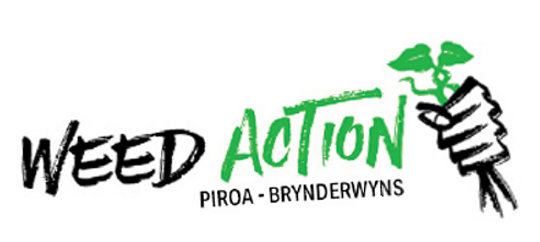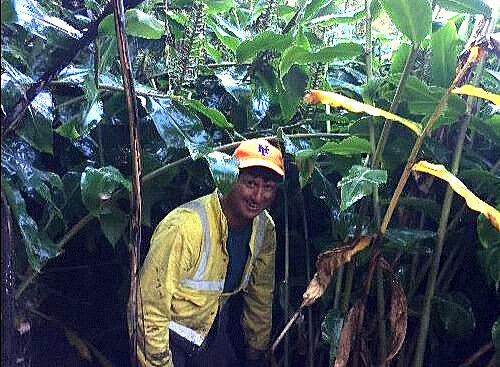Weed Control
The Trust is an active participant in a programme of activities intended to control signifiant infestations of invasive weeds in and around Langs Beach.
Our activities are undertaken under the guidance and direction of Weed Action Piroa/Brynderwyns, a division of the Piroa Conservation Trust.
Other sources of data on specific weeds, including those not included in our Dirty Dozen can be found at these sites:
NZ Environmental Weeds Council
And to help identify and report weeds, consider downloading the iNaturalist app to your phone - click here
Our local “Dirty Dozen”
The Trust has identified those weeds which are the most prevalent in the Langs Beach area and the focus of most of our weed control efforts locally.
We have called these our “Dirty Dozen” and have developed strategies to control them within our local environment.
These are listed below - click on the name to learn more about each weed and how to control it:
S.W.A.T
Our Specialist Weed Assistance Team is focused on identifying and addressing serious weed issues in the Langs Beach area.
We have a team of specialists who can help you identify weeds on or near your property and advise on practical steps to address those weeds. In many cases the team can help you to deal to the weeds through a targeted event or programme.
We also schedule regular events to target specific weed infestations, often in the reserves or other public areas but these can also take place on private properties.
See below for our next scheduled SWAT activity.
September 2nd 2023
Cove Road
This event will target the recently discovered infestation of Madiera or Mignonette vine that has infested a couple of roadside sites and if not eliminated, could spread widely and prolifically along our coast.
Click the button below if your available to help.
Weeds - a serious national Issue
New Zealand is one of the weediest countries in the world!
“Rampaging weeds pose a deadly threat to our native ecosystems by smothering, outcompeting and preventing regeneration of native plants,”
“Some plants that have naturalised here threaten to smother native ecosystems and prevent the regeneration of native plants. If left to their own devices, these weeds will transform our natural environment beyond recognition”.
For an island nation, New Zealand has a very high number of naturalised exotic plant species – it stands out globally in this regard. Over the years, humans have introduced more than 25,000 exotic vascular plant species to these islands, and nearly 3,000 of them have been found growing in the wild. Some do more than merely survive. Almost 1,800 exotic plant species are now considered naturalised. In other words, they have escaped cultivation and are successfully maintaining populations in the wild without human help. To put this botanical invasion in perspective, a recent study found that both the North Island and South Island have more naturalised plant species than almost any other island in the world.
On the other side of the botanical ledger, there are about 2,300 native vascular plant species growing in New Zealand. This means that for every four native plant species growing here, there are roughly three naturalised ones also growing in the wild. There are plenty of potential places for these naturalised plants to thrive. Widespread clearance of native forests has created a porous front that opens the remaining native ecosystems to invasion from naturalised plants.
These botanical incursions come not just from plants associated with production systems but also from urban development and sprawl. Many thousands of ornamental and horticultural plants have been brought here to look at and admire or eat. Problems arise when they escape their fields and gardens to spread across the landscape with unintended impacts in new settings.
This wave of leafy exotic invasion has not yet peaked. It is estimated that 20 new exotic plant naturalisations occur each year.6 Many of these are garden escapees. Without intervention, harm to native ecosystems will increase, not only as the existing naturalised invaders we know about continue their spread but as they are joined by these new ‘escapees’ that start to move away from where they have been deliberately planted.
New Zealanders have a responsibility to protect the native plants, animals and other life forms that are unique to Aotearoa. Nearly 80 per cent of the native plants found here are found nowhere else. If we do not care for them, no one else will. There is no doubt that some of the exotic plant species that have naturalised here pose a serious risk to some of our unique species and ecosystems – they are native ecosystem weeds.
The message is that we need to protect our native ecosystems from invasion by weeds
Have have a look at the report of the Parliamentary Commissioner for the Environment on the extent of weed problems and suggestions for how we might begin to address that.
-
The two most successful methods we use are mechanical removal and herbicides.
Mechanical methods involve hand pulling and disposal of weeds, sometimes with machinery for larger plants such as pampas
Herbicides are applied using knapsacks for weeds where infestations are large or mechanical methods are ineffective.
-
It all begins with an idea. Maybe you want to launch a business. Maybe you want to turn a hobby into something more. Or maybe you have a creative project to share with the world.
-
It all begins with an idea. Maybe you want to launch a business. Maybe you want to turn a hobby into something more. Or maybe you have a creative project to share with the world.





